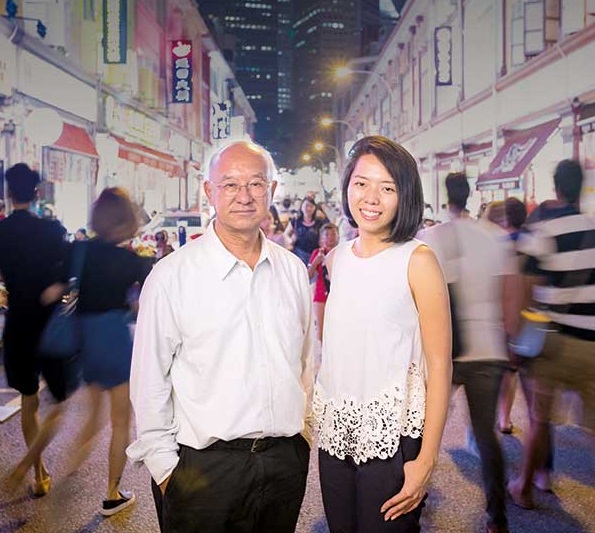No Cars, More Buzz

The preoccupation of building owners tends to be limited to collecting their monthly rental on time, but for Mr Tan Kay Toh, it’s about more. As one of the owners of 16 shophouses – almost half of the property on Liang Seah Street – he felt it was also important to improve the vicinity for his tenants and the public.
His idea: make Liang Seah Street more pedestrian-friendly, so it would attract a bigger crowd and boost local businesses. He has won the PS21 Star Customer Award, which recognises the contributions of members of the public who have worked with public agencies to create better outcomes for Singapore.
He was inspired as early as 20 years ago when he saw planter boxes placed along Joo Chiat Road to extend the walking area. He submitted proposals to the authorities to pedestrianise Liang Seah Street in 1998 and 2003, but these were turned down as “the government had different priorities back then and their concern was that this might lead to vehicle congestion in the area”, shared Mr Tan.
In 2013, the idea resurfaced in his mind when car-free zones were set up at the nearby Ann Siang Hill and Club Street.
“I talked to the people there and found it was good for their business. So I thought it could be good for us… maybe we could have it too,” Mr Tan recalled.
The stars aligned in 2015, when the Urban Redevelopment Authority (URA) proposed the same idea.

Working together
After the success of the first car-free zones, the URA was eager to explore similar initiatives in other areas. “Car-free zones can enliven the streets and draw more crowds to the area, creating a win-win situation for visitors and local stakeholders,” said its Executive Architect of Urban Design (Central Area) Lim Wei Qi.
For Liang Seah Street, the URA’s intention was for the initiative to be led by the local stakeholders, to encourage them to take ownership of their spaces. It could also promote neighbourliness between tenants and building owners by bringing them together to sustain the initiative and resolve differences, Ms Lim explained.
In January 2015, the URA had sent mailers and walked the street to explain their proposal to the tenants and building owners. They also invited them to dialogue sessions the following month, but many of those who attended the dialogue sessions were sceptical of the initiative.
“It’s understandable that the stakeholders are reluctant to change the status quo,” said Ms Lim. The tenants’ primary concern was losing parking space for their customers.
Mr Tan was one of the few stakeholders at the dialogue sessions who spoke out in support of the initiative. He enthusiastically volunteered to liaise between the URA and the stakeholders, and began his campaign to make the street a car-free zone.
He and his team went door to door, handing out flyers explaining what a road closure would entail. He spoke personally to building owners and tenants to alleviate their concerns, such as possible inconvenience for customers.
He identified alternative parking areas for customers and focused on how the initiative could draw more footfall to the area. He even volunteered his office for informal “town hall” meetings.
All that paid off, as most of the tenants eventually came on board.
Chipping in
The landlord went even further. When regulations by the Land Transport Authority, Singapore Police Force and Singapore Civil Defence Force required that road barriers and an electronic signage be erected, as well as having security manpower, Mr Tan took it upon himself to absorb the cost of a few thousand dollars to get those done.
“Somebody has got to do it. It might not be making money for us [the landlord], but we feel it’s good for tenants, and we want business to be good for them!” he exclaimed.
He also set up a website to post updates about the project, to help raise awareness.
In December 2015, Liang Seah Street began running a three-month car-free zone trial, which was a success. Today, the initiative is permanent, with the street closed every Friday,Saturday and Sunday evening for walking and al-fresco dining. Business has improved, with crowds filling the street on weekends.
Mr Tan remains the “chief ” of the street, overseeing arrangements and addressing feedback from the public.
“Everyone has been cooperative. Even though we expected problems, it turned out quite well,” he said. Aside from a few car owners grumbling about being unable to park there, no major issues have arisen.
He was also quick to credit the URA – throughout the process, they had advised and helped him in obtaining approvals from different agencies.
“Being URA officers, they have a thousand and one things to do. This is just one project, and probably additional work for them,” said Mr Tan.
At the URA, Ms Lim, too, values Mr Tan’s dedication.
She said: “Mr Tan’s personal efforts… are an inspiration to all of us and we are appreciative of the partnership.”
- POSTED ON
May 12, 2017
- TEXT BY
Fiona Liaw
- PHOTOS BY
John Heng
- ART DIRECTION BY
Yip Siew Fei









